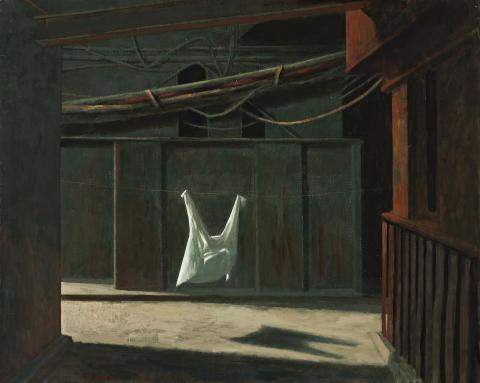STILL LIFE (INTERIOR), 1991 – 98
RICK AMOR
oil on linen
81.5 x 101.5 cm
signed and dated lower left: RICK AMOR ’91-98
inscribed and dated verso: INTERIOR / [...] / JAN 91 / MAR 98
Niagara Galleries, Melbourne (label attached verso)
Private collection, Melbourne
Menzies, Melbourne, 8 December 2011, lot 26
Private collection, London
Company collection, Sydney
Fry, G., Rick Amor, Beagle Press, Sydney, 2008, p. 34 (illus. as ‘Still Life, 1991’)
Still Life, 1992, oil on canvas, 116.0 x 75.0 cm, private collection, exhibited in A Single Mind: Rick Amor, Heide Museum of Modern Art, Melbourne, 22 March – 13 July 2008
A white shirt, pegged to an almost invisible washing-line, hangs limply in a shaft of sunlight creeping through the narrow alleyway of an inner city backstreet. Thoroughly deserted, the streets of Amor’s vision are indications of a disaster about to strike, or of one that has already struck. Rather than exuding calmness, the stillness and compositional simplicity of Amor’s Still Life (Interior), 1991 – 1998, produces a subtle sense of disquiet.
First painted in 1991, and later reworked by the artist in 1998, Still Life (Interior) is constructed on the basis of an unusual contradiction. Instead of presenting viewers with a saccharine arrangement of flowers and objects, Still Life (Interior) is an urban landscape, with an unsettling stillness so pervasive that it warrants the transition between genres. Similarly, the use of the word ‘interior’ in the title causes the viewer to speculate on the exact location of this scene. Like many of Amor’s urban landscapes, the scene is composite and imagined, not derived from precise geographical locations but instead coming from the artist’s own ‘secret city’, where dilapidated buildings and prosaic items take on multiple symbolic meanings and become representatives of people and emotions. With cinematic staging and lighting reminiscent of film noir, Amor’s cityscapes are informed by literature from T.S. Eliot to Kafka, as well as by fragments of the artist’s personal memory.
Still Life (Interior) is painted with a remarkably rich tonal palette; particularly present is an ochre colour that was added after 1991, emphasising the city’s rusted dereliction. The haunting vision is nevertheless dominated by the brilliant white of the hanging garment. Suspended with sleeves outstretched and collar hanging forlornly between the shoulders, the shape of the disembodied garment is reminiscent of a crucifixion. The dramatic lighting and deep, sculptural folds of the white shirt invite comparisons with similarly composed canonical works of Spanish art history, particularly Francisco de Zurbarán’s Saint Serapion, 1628 and Francisco Goya’s iconic The Third of May 1808, 1814. A potent symbol of surrender and righteous martyrdom in these Spanish works, its presence amongst Amor’s anonymous urban setting is incongruous and enigmatic. Although dwarfed in scale by an elevated tangle of pipes and girders reminiscent of Piranesi’s famous Carceri etchings, the shirt remains the clear focal point, placed squarely at the centre of Amor’s linear perspective.
LUCIE REEVES-SMITH
